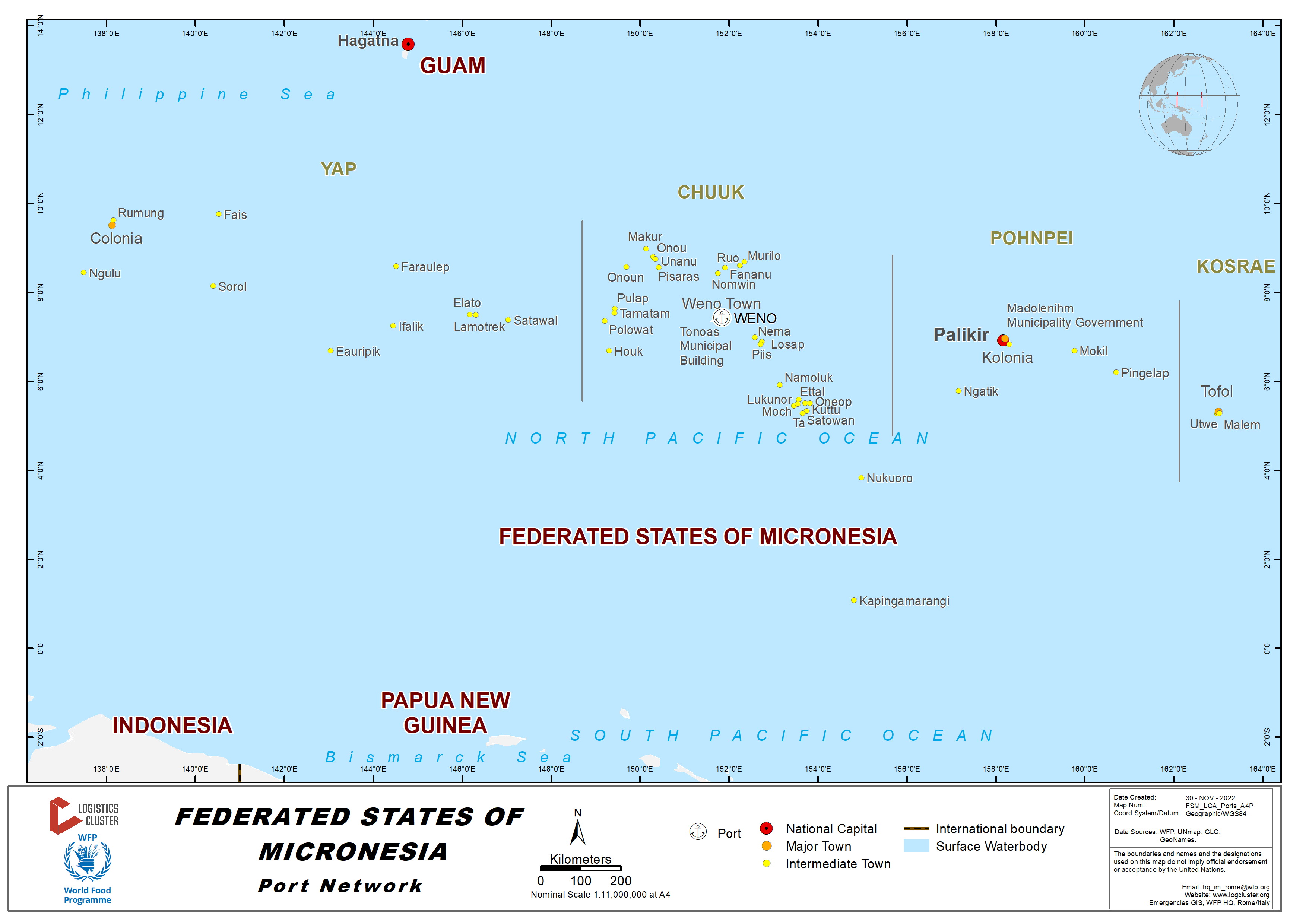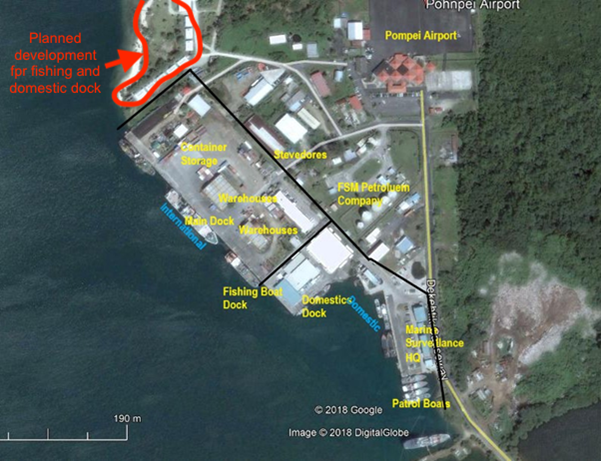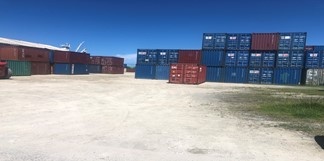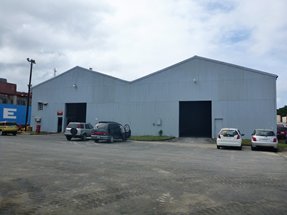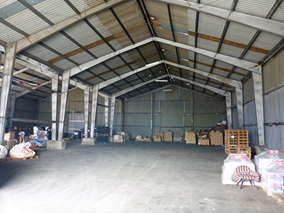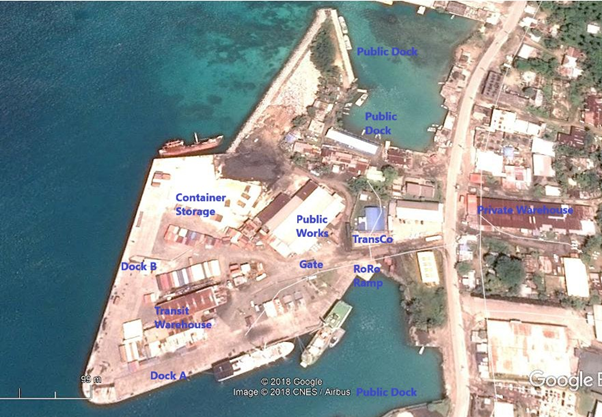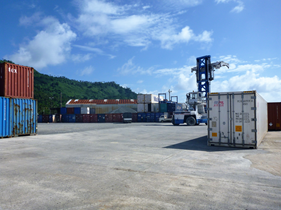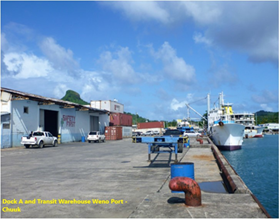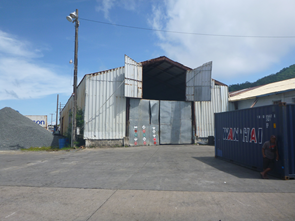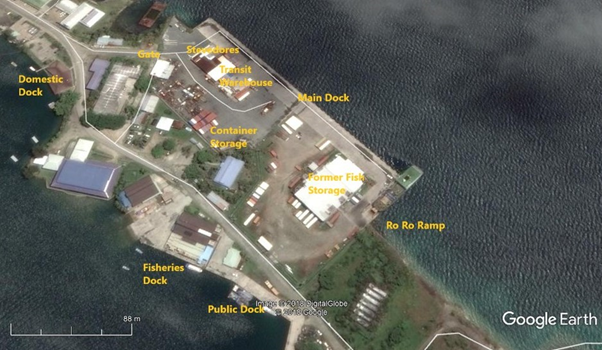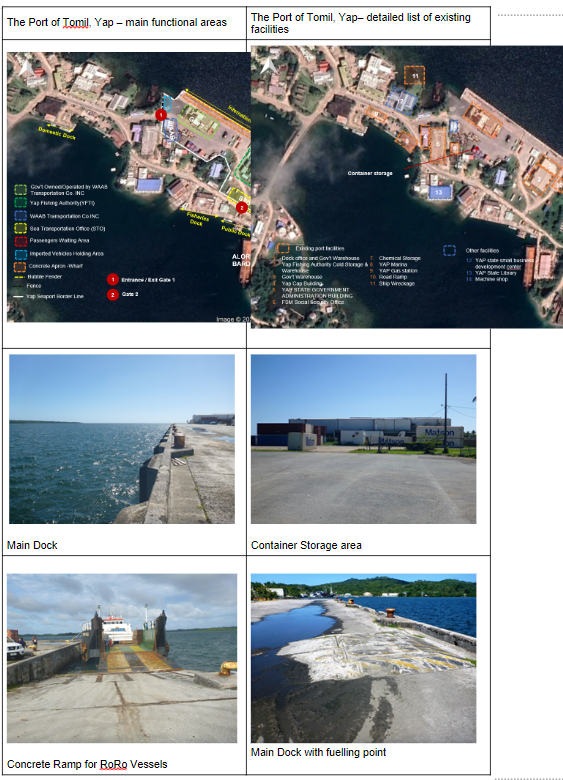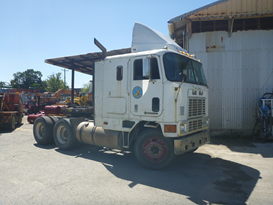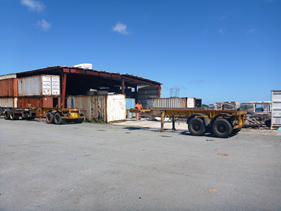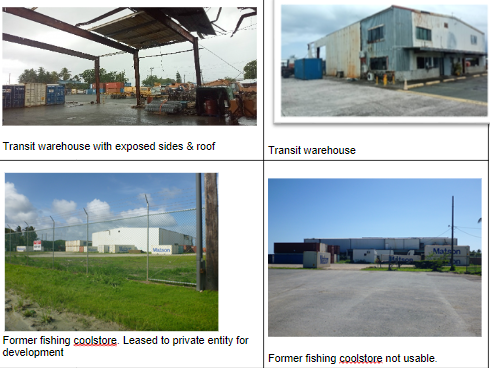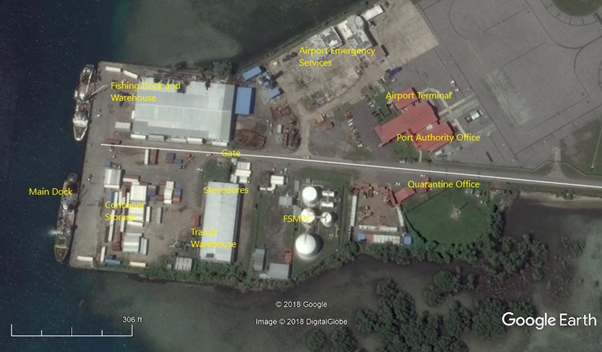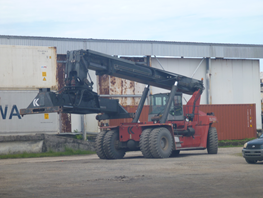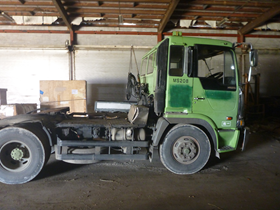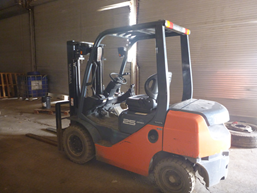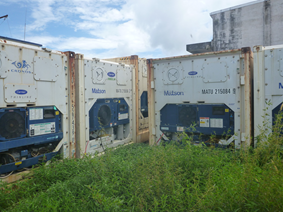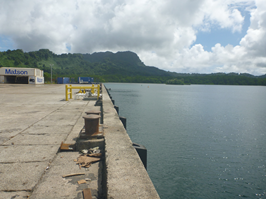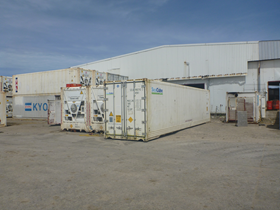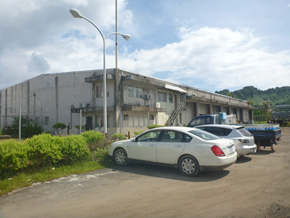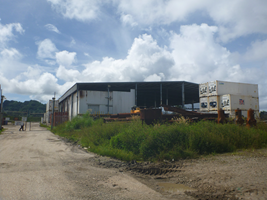2.1 Micronesia Port Assessment
Micronesia operates four international seaports, one in each state: Pohnpei, Chuuk, Yap and Kosrae.
In Pohnpei and Yap the ports are managed by a Port Authority while in Chuuk and Yao the ports are operated through the Department of Transport and Public works. All four ports are in a protected Lagoon environment
All ports are general ports and almost exclusively all in-bound and out-bound freight is containerised. While this is the case no wharf unloading container facilities exist other than a single 50 mt mobile crane in Pohnpei Port. All vessels visiting Micronesia's ports must have gantry cranes for loading and unloading.
All ports have top Loaders or reach stackers for moving and stacking containers once unloaded. Most equipment is in serviceable condition. Small numbers of key handling assets create a vulnerable point to reliable goods handling in the case of emergency.
In Pohnpei Port planning is well advanced to extend the current port footprint to increase container storage space and provide additional berthing to accommodate the fishing fleet and domestic shipping. This will allow dedicated berthing for international freight services. Estimated completion is two years.
2.1.1 Micronesia Port of Pohnpei
Port Overview
The Port of Pohnpei is located on the island of Pohnpei. Pohnpei is the capital of the Federated States of Micronesia and the National government is established in Palikir, Sokehs. The Port is operated by the Pohnpei Ports Authority and along with all other ports in FSM is overseen by the Department of Transportation Communication and Infrastructure. The port predominantly facilitates the import of goods for domestic use which is almost exclusively containerized freight.
The port is broken into four separate areas: International, Fishing, Domestic and Marine Surveillance.
The main dock encompasses the international and fishing dock with the domestic and marine surveillance dock adjacent to the main dock area.
Port website: http://www.ppa.fm
Key port information can also be found at: http://www.maritime-database.com
|
Port Location and Contact |
|
|---|---|
|
Country |
Federated States of Micronesia |
|
Province or District |
Pohnpei |
|
Nearest Town or City with Distance from Port |
Kolonia 2.5km |
|
Port's Complete Name |
Pohnpei Harbour |
|
Latitude |
6.979400 |
|
Longitude |
158.201225 |
|
Managing Company or Port Authority |
Pohnpei Port Authority |
|
Management Contact Person |
Grilly Jack |
|
Nearest Airport and Airlines with Frequent International Arrivals/Departures |
Pohnpei International Airport, adjacent to the Port United Airlines |
Port Picture
- International and Domestics Docks
- Fishing Boat Dock
- Warehouses
- Container Storage
- Stevedores
- Marine Surveillance Head Quarters
- Patrol Boats
- Pohnpei International Airport
Main dock
Description and Contacts of Key Companies
The Pohnpei Port Authority in addition to overall responsibility for all ports, airports and airfields throughout Pohnpei State handles the port terminal services. Stevedoring Services are provided by Federated Shipping Company (FSCO) a private company that undertakes all freight movements at the port as well as handling warehousing and storage of goods, piloting services and the delivery of containers and goods to site.
For more information on port contacts, please see the following link: 4.4 Micronesia Port and Waterways Companies Contact List.
Port Performance
The port handles approximately 3-5 cargo vessels per month almost exclusively container freight with Matson and Kyowa line providing scheduled services to Pohnpei. The port also receives bulk fuel vessels 2-3 times per month. The port handles approximately 80 containers of freight per month. The dock is situated inside a lagoon on the Northern side of Pohnpei.
The international dock is physically adjacent to the fishing and domestic dock, separated by a security fence.
Containers must all be unloaded by vessel gantry crane as no dockside container cranes or equipment are available at the dock. There is a 50MT mobile crane in the container storage area. Containers can generally be unloaded at 4-6 per hour.
The international port is not congested but the limited amount of handling equipment available could leave the port vulnerable in times of high need. The port handling equipment is in good condition. Adjacent to the international dock, at the southern end, is the fishing dock where tuna fishing vessels berth
Tuna fishing is the major export from FSM. In Pohnpei, transhipment is conducted at the anchorage area. After transhipment, fishing vessels proceed to the dock for provisioning, bunkering, maintenance and net repairs. At times fishing vessels berth 3 abreast causing congestion. All tuna fishing activities are privately operated.
The domestic dock lays south of the fishing dock and is the home base of the two FSM government owned freight and passenger vessels: the MV Caroline Voyager and the MV Micronesian Navigators. When both vessels are in port, due to space constraints, they are required berth side by side.
|
SEASONAL CONSTRAINTS |
||
|---|---|---|
|
Occurs |
Time Frame |
|
|
Rainy Season |
Yes |
November to April but does not affect operation unless severe event |
|
Major Import Campaigns |
No |
|
|
HANDLING FIGURES for 2022 |
|
|---|---|
|
Vessel Calls |
154 as of August 2022 |
|
Container Traffic (TEUs) |
1,683 as of August 2022 |
|
Handling Figures Bulk and Break Bulk for 2022 |
|
|---|---|
|
Bulk (MT) |
N/A |
|
Break bulk (MT) |
53,476.47 as of August 2022 |
Discharge Rates and Terminal Handling Charges
For information on port rates and charges, please see the following table:
|
Terminal Handling charges |
Cost USD |
Comments/ source |
|
Discharge/ Load |
9.24/ W/MT |
Association of Terminal Operators & Stevedoring Companies of Micronesia |
|
Discharge/Load Container 20’ w/cargo |
38.50/ movement |
|
|
Discharge/Load Container 40’ w/cargo |
42.35/ Movement |
|
|
Discharge/Load Container empty |
24.26/ Movement- 20’footer container 61.60 / Movement- 40’ footer container |
|
|
Straddle Carrier/Fork Under hook to yard or vis a versa |
20’ 15.40 /Movement 40’ 61.60 Movement |
|
|
Stuffing and unstuffing containers |
6.36/W/Mt |
|
|
LCL Bulk break goods unloading/loading International |
6.16/W/Mt |
|
|
Bulk break goods Domestic shipping |
12.63/W/MT |
|
|
Demurrage General freight Refrigerated fright |
5 Days No free time |
|
|
Demurrage charges Bulk break fright |
1.50/W/MT/Day Inside the Warehouse 1.00/W/MT/Day Outside the warehouse & unprotected |
|
|
Delivery |
||
|
Deliver/Return of containers to site |
$ 50.00 – Empty container $ 69.00 – Full container |
|
|
Port Fees |
|
Pohnpei Port Authority Seaport Rules & Regulations |
|
Entry fee:
|
$50.00 $0.06 per gross registered ton (grt) |
|
|
Dockage fee |
~ 0 up to 100 feet $35.00 ~ 101 up to 150 feet $50.00 ~ 151 up to 200 feet $60.00 ~ 201 up to 250 feet $95.00 ~ 251 up to 300 feet $115,00 ~ 301 up to 350 feet $155.00 ~ 351 up to 375 feet $215.00 ~ 376 up to 400 feet $255.00 ~ 401 up to 425 feet $265.00 ~ 426 up to 450 feet+ $285.00 ~ 451 up to 475 feet $305.00 ~ 476 up to 500 feet $355.00 ~501 feet up $405.00 |
|
|
Handling charges |
|
|
|
Aids to Navigation dues per port call |
$0.02 per grt |
|
|
Supplemental Port Services Fee |
|
|
Berthing Specifications
|
Type of Berth |
Quantity |
Length (m) |
Maximum Draft (m) |
Comments |
|---|---|---|---|---|
|
Conventional Berth |
1 |
264 70 60 |
12 |
International dock FIshing dock Domestic dock |
|
Container Berth |
No |
|
||
|
Silo Berth |
No |
|
||
|
Berthing Tugs |
No |
|
||
|
Water Barges |
No |
|
General Cargo Handling Berths
|
Cargo Type |
Berth Identification |
|---|---|
|
Imports - Bagged Cargo |
N/A |
|
Exports - Bagged Cargo |
N/A |
|
Imports and Exports - RoRo |
N/A |
|
Other Imports |
Vehicles |
Port Handling Equipment
The port equipment is owned and operated by Federated Shipping Company Ltd (FSCO) - a privately owned operator. The handling equipment is in good working condition with top loaders and large forklifts available.
Smaller forklifts are used for movement of palletized freight and are in good working condition. One mobile crane (50MT) has just been purchased and also available.
The top loaders move all containers from dockside to storage and load all tractor trailers for delivery. Consignees can also unload containers in the storage area in lieu of delivery
There are no tugmasters, and all containers are stacked and loaded directly on the container chassis by top loader. Containers chassis for 20 footers and 40 containers are available
FSCO maintains three prime movers/tractor for container delivery.
|
Equipment |
Available |
Total Quantity and Capacity Available |
Comments on Current Condition and Actual Usage |
|---|---|---|---|
|
Dockside Crane |
No |
||
|
Container Gantries |
No |
||
|
Mobile Cranes |
Yes |
1 x 50MT |
New |
|
Reachstacker |
Yes |
1 x 40 MT 1 x 30MT |
Operational |
|
RoRo Tugmaster (w/ Trailer) |
No |
||
|
Grain Elevator w/ Bagging Machines |
No |
||
|
Transtainer |
No |
||
|
Forklifts |
Yes |
1 x 28 MT 1 x 25 MT 1 x 12 MT 1 x 5 MT 1 x 4 MT 1 x 2 MT |
All operational |
|
Tractor unit single axle |
Yes |
1 |
operational |
|
Tractor unit double axle |
Yes |
1 |
operational |
50 mt crane
Reach stacker
Container Facilities
While almost all freight moving through the port is in containers the port has no dedicated container facility and operates as a general port.
|
Facilities |
20 ft |
40 ft |
|---|---|---|
|
Container Facilities Available |
N/A |
N/A |
|
Container Freight Station (CFS) |
N/A | N/A |
|
Refrigerated Container Stations |
Located at fishing dock. For private use. |
|
|
Other Capacity Details |
Storage space up to 800 containers | |
|
Daily Take Off Capacity |
7 | 4 |
|
Number of Reefer Stations |
17 connections point owned by a private fishing company (Luenthai Fishing Venture building adjacent to yard) | |
|
Emergency Take-off Capacity |
Dependent on vessel's capacity |
|
|
Off take Capacity of
Gang Shift |
25 | 15 |
Customs Guidance
As with all states in the FSM Customs is nationally controlled and regulated through the Department of Finance and Tax Administration. DFTA Customs officers are based in each state capital and attend the port upon the arrival of each vessel. Attendance at the port is dependent on the shipping arrivals schedule otherwise customs is located at the Government administration buildings between 8am-5pm Monday to Friday
Standard shipment documentation is required to clear customs and is processed at the port at state level. For tax and duty exemption the procedure is to obtain the exemption letter for humanitarian goods through DECEM and the Department of Transport and Infrastructure in Palikir and for such an exemption letter to be provided with the clearance documentation at the port level, ideally prior to the arrival of the shipment.
Clearance time for consignment is 24-48 hours and humanitarian goods will be prioritized in an emergency provided correct documentation is complete
For more information on customs in the Federated States of Micronesia, please see the following link: 1.3 Micronesia Customs Information.
Terminal Information
Multipurpose Terminal
Pohnpei Port is essentially a general terminal and all vessels must be compatible and equipped with the ability to load and unload i.e. Gantry cranes for containers or bulk break or bagged or ramped vessels for vehicle loading on to the flat dock.
There are three dock areas. International, Fishing Dock and the Domestic dock.
The Marine Surveillance dock lies adjacent to and south of the Domestic dock.
Grain and Bulk Handling
None
Main Storage Terminal
Pohnpei Port has two storage areas dock side. Two transit warehouses for bulk break freight and outside container storage
|
Storage Type |
Number of Storage Facilities |
Area (m2) |
|---|---|---|
|
Bagged Cargo |
Pohnpei Port has two storage areas dock side. 2 transit warehouses for bulk break freight and outside container storage |
570 m2 1,140 m2 |
|
Refrigerated Cargo |
Reefer containers only. Private (fishing company) chillers adjacent to dock area |
|
|
General Cargo |
1. Outside area container and vehicle storage 2. Warehouses as Dockside for Bulk break freight. |
7,500 m2 7,500 m2 |
|
|
|
|
Storage and Transit Warehouses |
Floor Storage |
Stevedoring
While the port operation falls under the Pohnpei Ports Authority, a single private company provides stevedoring services the Federated Shipping Company Ltd (FSCO). FSCO also undertakes all terminal services and local transport services. FSCO Offices are located adjacent to the dock area on the access road (refer map)
All ships operating at the port require gantry cranes to load/unload container freight. The Kyowa line uses RoRo vessels for the shipment of vehicles, which also fall under the responsibility of FSCO.
Stevedoring services are mechanical as are terminal services and the labour component is for the unstuffing of containers. During an emergency additional labour can be provided by FSCO.
Hinterland Information
FSCO provides distribution services through the use of container chassis. Containers are delivered to customers and dropped at the consignee’s site. Consignees have 5 days after vessel departure to unload containers. FSCO own 3 x prime mover /tractor and 20 trailers.
Private companies also operate their own tractors and trailers for collection of containers. Due to the limit on FSCO trailer availability it is often the case that containers and trailers are only returned on the day of the next vessels arrival whether this is outside the free period of not. As such demurrage is often not charged to regular customers
Port Security
Micronesia is not signatory to the ISPS Code, however, the U.S. has invested resources to assist the Federated States of Micronesia build the capacity to implement the ISPS Code to increase merchant trade.
Pohnpei Port operates under ISPS guidelines and has not recently undertaken an ISPS inspection due to the COVID-19 pandemic. As for previous inspection, the results are unknown at the time of writing. There was verbal acknowledgment from the Port Manager of some minor breaches that are difficult to rectify. The main issue is the location of a multi-story hotel that is adjacent to and overlooks the fence into the Commercial Port. To meet ISPS requirements the removal of the hotel is required. This is in the planning process and the site will ultimately accommodate a dock extension for use by the fishing fleet and domestic shipping. Timeline for this is 2-3 years.
|
Security |
|
|---|---|
|
ISPS Compliant |
Yes with current breaches |
|
Current ISPS
Level |
Level 1 |
|
Police Boats |
Yes -2 Patrol boats operated by the FSM Maritime Surveillance and Border Control |
|
Fire Engines |
Aircraft, Fire Fighting & Rescue (ARFF) stationed at airport adjacent. Fire Emergency stationed in town. |
2.1.3 Micronesia Port of Chuuk
Port Overview
The port of Weno is operated through the State government Department of Transport and Public works who has responsibility for both the seaports and airports throughout Chuuk.
The port consists of two main docks and hosts both Intentional and domestic shipping.
Freight through the terminal is almost exclusively container freight with the exception of vehicles. No bulk break cargo is moved unless it is in an LCL containers bulk or bagged commodities are received or handled internationally. Bulk break goods are however handled on domestic shipping legs.
Chuuk (formerly Truk) lagoon has a significant maritime history being the service port for Japanese fleet during WW2. As such the access and shelter provided to ships including aircraft carriers is historically easily accommodated.
Port website: http://www.ict.fm/transportation-marine.html
Key port information can also be found at: http://www.maritime-database.com
|
Port Location and Contact |
|
|---|---|
|
Country |
Federated States Of Micronesia |
|
Province or District |
Moen |
|
Nearest Town or City with Distance from Port |
Weno 1 Km |
|
Port's Complete Name |
Port of Chuuk |
|
Latitude |
72645.52 N |
|
Longitude |
1515023.61 E |
|
Managing Company or Port Authority |
Dept Transport and Public Works |
|
Management Contact Person |
John Smith Port Manager |
|
Nearest Airport and Airlines with Frequent International Arrivals/Departures |
Chuuk International Airport Air Nugini United Airlines |
Port Picture
Description and Contacts of Key Companies
The port terminal services and stevedoring is handled by a private company Transco. Piloting services are handled by private operators.
Chuuk Department of transport and Public works are responsible for the administration and regulations of Weno Port. However all port operations are contracted out to private companies.
Transco are the main contractors and are responsible for all terminal services and stevedoring. Piloting services are available through Transco through a subcontracted pilot.
For more information on port contacts, please see the following link: 4.4 Micronesia Port and Waterways Companies Contact List
Port Performance
The port itself handles approximately 5 cargo vessels per month almost exclusively container freight with Matson and Kyowa line providing scheduled services to Chuuk. The dock is situated on Weno Island inside Truk lagoon and access is via channels through the outer reef. With 2 docks 190m and 185M long the largest vessel accommodated at the dock was 13000 tons. Larger ships may anchor in the lagoon.
Containers must all be unloaded by Gantry crane as no container cranes are available at the dock. Depending on ships gantry crane capacity. Containers can generally be unloaded at 6-10 per hour.
The port is not congested but the limited amount handling equipment used on the port could leave the port vulnerable in times of high need. Port handling equipment was in good condition but only a small number were available.
|
SEASONAL CONSTRAINTS |
||
|---|---|---|
|
Occurs |
Time Frame |
|
|
Rainy Season |
Yes |
November to April but does not affect operation unless severe event |
|
Major Import Campaigns |
No |
|
|
Other Comments |
|
|
|
HANDLING FIGURES for 2017 |
|
|---|---|
|
Vessel Calls |
60 per year |
|
Container Traffic (TEUs) |
750 per year |
|
Handling Figures Bulk and Break Bulk for 2017 |
|
|---|---|
|
Bulk (MT) |
None |
|
Break bulk (MT) |
Approx 150-200 MT/Year |
Discharge Rates and Terminal Handling Charges
For information on port rates and charges, please see the following table:
|
Terminal Handling charges |
Cost |
Comments/ source |
|
Entry |
10c/GRT |
Transco |
|
Anchorage |
USD150/24hrs |
Transco |
|
Dockage/Berthing |
USD 0.7cGRT/24hrs |
Transco |
|
Wharfage Load/Unload |
10c/GRT |
Transco |
|
Bulk break |
USD 1.75/m3 |
Transco |
|
Customs |
4% of CIF |
Transco |
|
Demurrage after 10 days Dockside |
20’ USD 62.10/day +5% state tax 40’ USD 124.20/day +5% state tax |
Transco |
|
Clearance |
||
|
Shipping Agent Handling charges for customs clearance only. |
USD52.50 10% of 4% CIF |
Transco |
|
Storage Bulk break freight |
USD 2.30/m3 |
Transco |
|
Shipping Agent handling charges for clearing containers |
20’ USD 210 40’ USD 425 |
Transco |
|
Delivery |
||
|
Delivery of containers to site |
20’ USD 189 40’ USD 217 |
Transco |
|
Demurrage is charged after 3 days at the following rates |
20’ USD65.21/day 40’ USD130.41.20/day |
Transco |
|
Container moving/loading unloading to site outside dock |
Tractor rental USD 175/hr Trailer Rental USD50/hr 2 forklifts required to unload empty container USD183/hr |
Transco |
Berthing Specifications
|
Type of Berth |
Quantity |
Length (m) |
Maximum Draft (m) |
Comments |
|---|---|---|---|---|
|
Conventional Berth |
2 | 180 and 190 | 9 |
|
|
Container Berth |
no |
|
||
|
Silo Berth |
no |
|
||
|
Berthing Tugs |
no |
|
||
|
Water Barges |
|
A concrete RoRo ramp available for front ramp vessels including landing craft.
General Cargo Handling Berths
|
Cargo Type |
Berth Identification |
|---|---|
|
Imports - Bagged Cargo |
NA |
|
Exports - Bagged Cargo |
NA |
|
Imports and Exports - RoRo |
NA |
|
Other Imports |
Vehicles |
Port Handling Equipment
The port equipment is owned and managed by Transco - a private operator. The handling equipment seen was in good condition although only single top loader is available. Smaller forklift for movement of palletised freight are available and in fair condition.
The top loader moves all containers from dockside to storage and loads all tractor trailers for delivery. Consignees can also unload containers in the storage area in lieu of delivery
There are no tug masters and all containers are stacked and loaded directly upon the
Delivery equipment (being trailer chassis) by the single top loader. Transco maintains a single prime mover/tractor for delivery.
|
Equipment |
Available |
Total Quantity and Capacity Available |
Comments on Current Condition and Actual Usage |
|---|---|---|---|
|
Dockside Crane |
No |
||
|
Container Gantries |
No |
||
|
Mobile Cranes |
No |
||
|
Reachstacker |
Yes |
30 MT | good |
|
RoRo Tugmaster (w/ Trailer) |
No |
||
|
Grain Elevator w/ Bagging Machines |
No |
||
|
Transtainer |
No |
||
|
Forklifts |
Yes |
1 X 2 MT 1 X 5 MT 1 X 6 MT |
Container Facilities
While almost all freight moving through the port in containers the port has no dedicated container facility and operates as a general port.
|
Facilities |
20 ft |
40 ft |
|---|---|---|
|
Container Facilities Available |
NA |
NA |
|
Container Freight Station (CFS) |
NA | NA |
|
Refrigerated Container Stations |
NA | NA |
|
Other Capacity Details |
Unknown | |
|
Daily Take Off Capacity |
Unknown | |
|
Number of Reefer Stations |
None | |
|
Emergency Take-off Capacity |
Dependent on vessel |
Dependent on vessel |
|
Off take Capacity of
Gang Shift |
Customs Guidance
As will all states in the FSM Customs is nationally controlled and regulated through the Department of Finance and Tax Administration. DFTA Customs officers are based in each state capital and attend the airport upon the arrival of each vessel. Attendance at the port is dependent on the schedule otherwise customs is located at the Government administration buildings between 8am-5pm M-F
Standard shipment documentation is required to clear customs and is processed at the port at state level. For tax and duty exemption the procedure is to obtain the exemption letter for humanitarian goods through DECEM and the Dept of Transport and Infrastructure in Palikir and for such an exemption letter to be provided with the clearance documentation at the port level ideally prior to the arrival of the shipment.
Clearance time for consignment is 24-48 hours and humanitarian goods will be prioritised in an emergency provided correct documentation is complete
For more information on customs in the Federated States of Micronesia, please see the following link: 1.3 Micronesia Customs Information.
Terminal Information
Multipurpose Terminal
Weno port is essentially a general terminal and all vessel must be compatible and equipped with the ability to load and unload i.e. Gantry cranes for containers or bulk break or bagged or Ramped vessels for vehicle loading on to the flat dock.
There are 2 general docks areas 180m and 190m long by 20m wide.
The Domestic RoRo ramp is situated outside the main dock adjacent to the east end of Dock A for use with front ramp landing craft.
Main Storage Terminal
Weno Port has two storage areas dock side this a transit warehouse for Bulk break fright and outside container storage Please see map above
|
Storage Type |
Number of Storage Facilities |
Area (m2) |
|---|---|---|
|
Bagged Cargo |
No specific areas for bagged cargo only dock side transit warehouses used for bulk break or bagged goods |
700 m2 |
|
Refrigerated Cargo |
None | |
|
General Cargo |
1 – Dockside for Bulk break freight 2 Outside Dock area Containers and general (Public works) |
700 m2 6000 m2 |
|
|
|
|
Transit warehouse for LCL Bulk break freight |
Warehouse adjacent to transit warehouse |
Stevedoring
While the port operation falls under the Department of Public Works and Transport stevedoring services are provided by a single private company Transco. Transco also undertakes terminal services. Transco also provide services as a shipping agent and local transport services. Transco Offices are located adjacent to the Dock area on the access road (refer map)
All ships operating at the port require gantry cranes to load/unload all container freight. The Kyowa line uses RoRo vessels for the shipment of vehicles which also fall under the responsibility of Transco.
Stevedoring services are mechanical as are terminal services and the labour component is for the unstuffing of containers. During an emergency additional labour can be provided by the dept of Public owrks and transport of needed.
Hinterland Information
The private Terminal services operator Transco also provides distribution services through the use of container chassis. Containers are delivered to customers and dropped at the consignee’s site. Consignees have 3 days after vessel departure to unload containers. Transco own 1 x prime mover /tractor and 8 trailers.
Demurrage is charged after 3 days at the following rates
20’ container USD65.21/day
40”container USD130.41.20/day
Port Security
Micronesia is not signatory to the ISPS Code, however, the U.S. has invested resources to assist the Federated States of Micronesia build the capacity to implement the ISPS Code to increase merchant trade.
Weno Port operates under ISPS guidleines and has recently undertaken an inspection (January 2018) While the results are unknown at the time of writing there was verbal acknowledgment from the Port Manager of some minor breaches which are rectifiable. Surveillance
|
Security |
|
|---|---|
|
ISPS Compliant |
Yes with current breaches |
|
Current ISPS
Level |
No indication of level by Port Manager |
|
Police Boats |
No |
|
Fire Engines |
None observed on site. Fire services based at airport available |
2.1.4 Micronesia Port of Yap
Port Overview
The port of Yap is operated through the State Government Department of Public Works and Transportation who has responsibility for both the seaports and airports throughout Yap.
The port consists of a single main dock for international freight inside a security perimeter with two public accessible domestic docks close adjacent to the international dock.
Freight through the terminal is almost exclusively container freight with the exception of vehicles. No bulk break cargo is moved unless it is in an LCL container, bulk or bagged commodities are received or handled internationally. Bulk break goods are however handled on domestic shipping legs.
Main dock infrastructure is poor with cyclone damaged warehouses and structures in disrepair. Handling equipment is in fair to poor condition. Terminal services are provided by a private company undertaking stevedoring and freight handling.
Port website: NA
Key port information can also be found at: http://www.maritime-database.com
|
Port Location and Contact |
|
|---|---|
|
Country |
Federated States Of Micronesia |
|
Province or District |
Colonia Yap State |
|
Nearest Town or City with Distance from Port |
Colonia 1 Km |
|
Port's Complete Name |
Colonia Yap International Port |
|
Latitude |
9.311593 N |
|
Longitude |
138.73388 E |
|
Managing Company or Port Authority |
WAAB Transportation Company |
|
Management Contact Person |
George R. Torwan |
|
Nearest Airport and Airlines with Frequent International Arrivals/Departures |
Yap International Airport United Airlines Pacific Missionary Aviation Caroline Islands Air Air Nauru |
Port Picture
- Domestic Dock
- Fisheries Dock
- Gate
- Stevedores
- Transit warehouse
- Container storage
- Main dock
- RoRo Ramp
Description and Contacts of Key Companies
Yap Department of Transport and Public Works are responsible for the administration and regulations of Colonia Port. However, all port operations are contracted out to private companies.
WAAB is the main contractor and is responsible for all terminal services and stevedoring. Piloting services are available through WAAB and carrier agents through a subcontracted pilot.
For more information on port contacts, please see the following link: 4.4 Micronesia Port and Waterways Companies Contact List.
Port Performance
The port handles approximately 3- 5 cargo vessels per month almost exclusively container freight with Mariana Express Line Ltd and Kyowa line providing scheduled services to Yap. The dock is situated at Colonia. With the main dock covering 264m. The dock can accommodate vessels up to 500ft.
Containers must all be unloaded by ship’s gantry crane as no container cranes are available at the dock. Containers can generally be unloaded at 6-10 per hour.
The port is not congested but the limited amount of handling equipment available at the port could leave the port vulnerable in times of high need. Port handling equipment is in poor condition with only a small amount available with major equipment undergoing repairs.
Transit warehouse facilities were also in poor condition with walls and ceiling exposed due to the damage caused in 2006 by Typhoon Ester. Apart from the removal of debris no further repair or reconstruction has been undertaken. The minimal level and poor condition of large handling equipment is a potential bottleneck in the event of an emergency.
|
SEASONAL CONSTRAINTS |
||
|---|---|---|
|
Occurs |
Time Frame |
|
|
Rainy Season |
Yes |
November to April but does not affect operation unless severe event |
|
Major Import Campaigns |
No |
|
|
Other Comments |
Easterly Winds that start in October and often gust up to 20kn which affect the vessel capacity to kick away from the dock |
|
|
HANDLING FIGURES for 2017 |
|
|---|---|
|
Vessel Calls |
60 |
|
Container Traffic (TEUs) |
720 |
|
Handling Figures Bulk and Break Bulk for 2022 |
|
|---|---|
|
Bulk (MT) |
N/A |
|
Break bulk (MT) |
N/A |
Discharge Rates and Terminal Handling Charges
For information on port rates and charges, please see the following table:
|
Terminal Handling Charges |
Cost USD |
|---|---|
|
Yap State Government Charges |
|
|
Dockage |
10c/GRT |
|
Entry |
10c/GRT |
|
Warfage |
USD 1.25/W/MT |
|
Bulk break |
USD 6.50/W/MT |
| WAAB Charges | |
|
Handling and loading |
USD 2.50/W/MT |
|
Container delivery |
20’ USD 148 (Colonia) 40’ USD 170 (Colonia) |
Berthing Specifications
|
Type of Berth |
Quantity |
Length (m) |
Maximum Draft (m) |
Comments |
|---|---|---|---|---|
|
Conventional Berth |
2 | 264 | 4-12 |
|
|
Container Berth |
no |
|
||
|
Silo Berth |
no |
|
||
|
Berthing Tugs |
no |
|
||
|
Water Barges |
|
A concrete RoRo Berth is available at the eastern end of the port which is easily able to handle RoRo ramp vessel up to 500MT load capacity
General Cargo Handling Berths
|
Cargo Type |
Berth Identification |
|---|---|
|
Imports - Bagged Cargo |
NA |
|
Exports - Bagged Cargo |
NA |
|
Imports and Exports - RoRo |
Vehicle imports |
|
Other Imports |
Port Handling Equipment
The port equipment is owned and managed by WAAB - a private operator. The handling equipment is in poor condition with a single top lifter available but constantly under repair before use. Smaller forklifts for movement of palletized freight are available and in fair condition.
The top lifter moves all containers from dockside to storage and loads all tractor trailers for delivery. consignees can also unload containers in the storage area in lieu of delivery
There are no tug masters, and all containers are stacked and loaded directly upon the delivery equipment (being trailer chassis) by the single top lifter WAAB maintains a single prime mover/tractor for delivery.
|
Equipment |
Available |
Total Quantity and Capacity Available |
Comments on Current Condition and Actual Usage |
|---|---|---|---|
|
Dockside Crane |
No |
||
|
Container Gantries |
No |
||
|
Mobile Cranes |
No |
||
|
Reachstacker |
Yes |
Not operational | |
|
RoRo Tugmaster (w/ Trailer) |
No |
||
|
Grain Elevator w/ Bagging Machines |
No |
||
|
Transtainer |
No |
||
|
Forklifts |
Yes |
1 X 25 mt 1 X 3 mt 1 x 2 mt |
Serviceable with 20+ years use Under repair Serviceable |
|
Top Loader under repair |
25MT Forklift for container moving |
|
WAAP Tractor unit for deliveries |
Container chassis. |
Container Facilities
While almost all freight moving through the port is in containers the port has no dedicated container facility and operates as a general port.
|
Facilities |
20 ft |
40 ft |
|---|---|---|
|
Container Facilities Available |
NA |
NA |
|
Container Freight Station (CFS) |
NA | NA |
|
Refrigerated Container Stations |
NA | NA |
|
Daily Take Off Capacity |
Dependant on ships capability (approx. 7/hour) |
|
|
Number of Reefer Stations |
None | |
|
Emergency Take-off Capacity |
Dependant on ships capability |
|
|
Off take Capacity of
Gang Shift |
Dependant on ships
capability |
|
Customs Guidance
As with all states in the FSM Customs is nationally controlled and regulated through the Department of Finance and Tax Administration. DFTA Customs officers are based in at the adjacent near the YCA building attend the port upon the arrival of each vessel. Attendance at the port is dependent on the schedule otherwise customs is located at the Government administration buildings between 8am-5pm M-F
Standard shipment documentation is required to clear customs and is processed at the port at state level. For tax and duty exemption the procedure is to obtain the exemption letter for humanitarian goods through DECEM and the Dept of Transport and Infrastructure in Palikir and for such an exemption letter to be provided with the clearance documentation at the port level ideally prior to the arrival of the shipment.
Clearance time for consignment is 24-48 hours and humanitarian goods will be prioritized in an emergency provided correct documentation is complete
For more information on customs in Micronesia, please see the following link: 1.3 Micronesia Customs Information.
Terminal Information
Multipurpose Terminal
Yap port is essentially a general terminal and all vessel must be compatible and equipped with the ability to load and unload i.e. Gantry cranes for containers or bulk break or bagged or ramped vessels for vehicle loading on to the flat dock.
There is one main general dock at 264m x 20m wide. A concrete RoRo ramp is situated outside the main dock adjacent to the east end of Dock A for use with front ramp landing craft.
Grain and Bulk Handling
No faclilities.
Main Storage Terminal
Storage at the terminal is poor and cannot be expected to be used in an emergency as it can only handle small amounts of freight. Damage to the building caused by cyclones has rendered the building exposed to the elements.
|
Storage Type |
Number of Storage Facilities |
Area (m2) |
|---|---|---|
|
Bagged Cargo |
General cargo only | |
|
Refrigerated Cargo |
No | |
|
General Cargo |
1 in poor condition | 200 m2 |
Stevedoring
While the port operation falls under the Department of Public Works and Transport stevedoring services are provided by a single private company WAAB which undertakes all terminal services. WAAB also provide services as a shipping agent and local transport services. WAAB offices are located at the dock in the transit warehouse.
All ships operating at the port require gantry cranes to load/unload all container freight. The Kyowa line uses RoRo vessels for the shipment of vehicles which also fall under the responsibility of WAAB
Stevedoring services are mechanical as are terminal services and the labour component is for the unstuffing of containers. During an emergency additional labour can be provided by the Dept of Public Works and Transport if needed.
Hinterland Information
The private Terminal services operator WAAB also provides distribution services through the use of container chassis. Containers are delivered to customers and dropped at the consignee’s site. Consignees have 10 days after vessel departure to unload containers. WAAB own 1 x prime mover /tractor and no trailers. MELL Shipping owns 5 trailers and Matson Shipping owns 5 trailers which are all towed buy WAAB. There is only 1 x 40’ trailer available.
Demurrage is charged after 10 days at the following rates
20’ container USD4.00 day/unit
40”container USD6.25 day/unit
There are no side loading container chassis available so all containers that require unloading at the site require forklifts to unload. The 25MT forklift can be hired at USD$175/hour
Port Security
Micronesia is not signatory to the ISPS Code; however, the U.S. has invested resources to assist the Federated States of Micronesia build the capacity to implement the ISPS Code to increase merchant trade.
Yap Port operates under ISPS guidelines and has recently undertaken an inspection (January 2018) While the results are unknown at the time of writing there was verbal acknowledgment from the Port Manager of some minor breaches.
Entry to the Port requires photo ID which is held by security during the visit. The port is only accessible to persons involved in the collection of freight. It is also common for containers to be unloaded in the port area onto private transport as such despite the small volume the port is open to traffic for such purposes.
|
Security |
|
|---|---|
|
ISPS Compliant |
Yes, with current breaches |
|
Current ISPS
Level |
No indication of level by Port Manager |
|
Police Boats |
No |
|
Fire Engines |
None at commercial port. Fire services based at airport available |
2.1.2 Micronesia Port of Kosrae
Port Overview
Port of Kosrae (Micronesia)
The port of Kosrae is operated through the Kosrae Port Authority who has responsibility for both the seaports and airports throughout Yap.
The port consists of a single main dock for international freight inside a security perimeter
Kosrae is serviced by Matson and Kyowa shipping lines via Guam for general freight and Marianas Shipping lines who provide freight services to the tuna fishing industry
Freight through the terminal is almost exclusively container freight with the exception of vehicles. No bulk break cargo is moved unless it is in an LCL containers bulk or bagged commodities are received or handled internationally. Bulk break goods are however handled on domestic shipping legs.
Main dock infrastructure is in good condition with a solid warehouses facility. Handling equipment is also in fair to good condition. Terminal services are provided by Kosrae Terminal Services and Stevedoring Company KTSSC a private company undertaking stevedoring and freight handling.
Port website: NA
Key port information can also be found at: http://www.maritime-database.com
|
Port Location and Contact |
|
|---|---|
|
Country |
Federated States of Micronesia |
|
Province or District |
Okay |
|
Nearest Town or City with Distance from Port |
Tofol 10 Km |
|
Port's Complete Name |
Kosrae International Port |
|
Latitude |
5.2101 N |
|
Longitude |
162.5724 E |
|
Managing Company or Port Authority |
Kosrae Port Authority |
|
Management Contact Person |
Jesse Tulensru |
|
Nearest Airport and Airlines with Frequent International Arrivals/Departures |
Kosrae Airport United Airlines Caroline Islands Air |
Port Picture
- Gate
- Stevedores
- Transit Warehouse
- Container storage
- Main dock
- Port Authority
- Airport Terminal
- Fishing Dock and Warehouse
- FSMPC (FSM Petroleum Company
Description and Contacts of Key Companies
Kosrae Port Authority are responsible for the administration and regulations for Kosrae Port.
However all port operations are contracted out to KTSC a private company who are responsible for all terminal services and stevedoring. Piloting services are available through a subcontracted pilot.
For more information on port contacts, please see the following link: 4.4 Micronesia Port and Waterways Companies Contact List.
Port Performance
The port handles approximately 3- 5 cargo vessels per month almost exclusively container freight with Matson and Kyowa line providing scheduled services to Kosrae. The dock is situated adjacent to the Aiport. With the main dock 170 m. The Dock can accommodate vessels up to 500ft
Containers must all be unloaded by gantry crane as no container cranes are available at the dock. Containers can generally be unloaded at 6-10 per hour.
The port is not congested but the limited amount handling equipment used on the port could leave the port vulnerable in times of high need. Port handling equipment was in good condition with only a small amount available.
Transit warehouse facilities were also in good condition with multiple doors
|
SEASONAL CONSTRAINTS |
||
|---|---|---|
|
Occurs |
Time Frame |
|
|
Rainy Season |
Yes |
November to April but does not affect operation unless severe event |
|
Major Import Campaigns |
No |
|
|
Other Comments |
|
|
|
HANDLING FIGURES for 2017 |
|
|---|---|
|
Vessel Calls |
60 |
|
Container Traffic (TEUs) |
250 |
|
Handling Figures Bulk and Break Bulk for 2017 |
|
|---|---|
|
Bulk (MT) |
NA |
|
Break bulk (MT) |
|
Discharge Rates and Terminal Handling Charges
For information on port rates and charges, please see the following table:
|
Terminal Handling Charges |
Cost USD |
|
|
|
|
|
|
Dockage |
14c/GRT |
|
|
Anchorage |
10c/GRT |
|
|
Line Handling |
100/vessel |
|
|
Navigational Aid fee |
15/Vessel |
|
|
Wharfage |
25c/GRT |
|
|
Pilot |
18c/GRT/move |
|
|
|
|
|
|
Container unload of vessel |
20’ 34.50 40’ 67.25 |
|
|
Container Empty unload of vessel |
20’ 23.25 40’ 37.55 |
|
|
Stuff/unstuffing From Container to Container |
4.85/W/MT |
|
|
Container to Freight Station |
5.65/W/MT |
|
|
Shifting container |
20’ 23.25/move 40’45.25/move |
|
|
Bulk break Cargo handling |
6.05W//MT |
|
|
Container Loading onto truck |
20’ 9.5/W/MT 40’ 14.22/W/MT |
|
|
Container Loading onto truck-Empty |
20’ 96.4/W/MT 40’ 8.15/W/MT |
|
|
Container Delivery |
125/move |
|
Berthing Specifications
|
Type of Berth |
Quantity |
Length (m) |
Maximum Draft (m) |
Comments |
|---|---|---|---|---|
|
Conventional Berth |
1 | 165 | 9 |
|
|
Container Berth |
no |
|
||
|
Silo Berth |
no |
|
||
|
Berthing Tugs |
no |
|
||
|
Water Barges |
|
General Cargo Handling Berths
|
Cargo Type |
Berth Identification |
|---|---|
|
Imports - Bagged Cargo |
NA |
|
Exports - Bagged Cargo |
NA |
|
Imports and Exports - RoRo |
vehicle imports |
|
Other Imports |
Port Handling Equipment
The port equipment is owned and managed by KTSC a private operator. The handling equipment seen was in Good condition with a single top loader available. A second Top loader has been purchased and KTSC is awaiting its arrival in February. Smaller forklifts for movement of palletised freight are available and in fair condition.
The top loader moves all containers from dockside to storage and loads all tractor trailers for delivery. consignees can also unload containers in the storage area in lieu of delivery
There are no tug masters and all containers are stacked and loaded directly upon the delivery equipment (being trailer chassis) by the single top loader. KTSC maintains 1 single prime mover/tractor for delivery.
|
Equipment |
Available |
Total Quantity and Capacity Available |
Comments on Current Condition and Actual Usage |
|---|---|---|---|
|
Dockside Crane |
No |
||
|
Container Gantries |
No |
||
|
Mobile Cranes |
No |
||
|
Reachstacker |
Yes |
1 X 35 MT | Good Condition. A second reach staker is available and belongs to the fishing company occupying part of the Port |
|
RoRo Tugmaster (w/ Trailer) |
No |
||
|
Grain Elevator w/ Bagging Machines |
No |
||
|
Transtainer |
No |
||
|
Forklifts |
Yes |
1 X 35 MT 2 X 5 MT 1 X 3 MT |
|
Trailer chassis Top loader in rear |
25MT Reach Stacker belonging to Fishing company |
|
|
Container chassis. |
Container Facilities
While almost all freight moving through the port is in containers the port has no dedicated container facility and operates as a general port.
|
Facilities |
20 ft |
40 ft |
|---|---|---|
|
Container Facilities Available |
NA |
NA |
|
Container Freight Station (CFS) |
NA | NA |
|
Refrigerated Container Stations |
Yes | Yes |
|
Other Capacity Details |
Unknown | |
|
Daily Take Off Capacity |
Unknown | |
|
Number of Reefer Stations |
80 | 80 |
|
Emergency Take-off Capacity |
Dependent on vessel |
Dependent on vessel |
|
Off take Capacity of
Gang Shift |
|
Container Marshalling and Storage area |
Reefer Station Domestic |
|
Main Dock with fuelling point |
Reefer stations Generator powered |
Customs Guidance
As with all states in the FSM Customs is nationally controlled and regulated through the Department of Finance and Tax Administration. DFTA Customs officers are based in at the adjacent near the YCA building attend the port upon the arrival of each vessel. Attendance at the port is dependent on the schedule otherwise customs is located at the Government administration buildings between 8am-5pm M-F
Standard shipment documentation is required to clear customs and is processed at the port at state level. For tax and duty exemption the procedure is to obtain the exemption letter for humanitarian goods through DECEM and the Dept of Transport and Infrastructure in Palikir and for such an exemption letter to be provided with the clearance documentation at the port level ideally prior to the arrival of the shipment.
Clearance time for consignment is 24-48 hours and humanitarian goods will be prioritised in an emergency provided correct documentation is complete
For more information on customs in COUNTRY NAME, please see the following link: 1.3 Micronesia Customs Information.
Terminal Information
Multipurpose Terminal
Kosrae port is essentially a general terminal and all vessel must be compatible and equipped with the ability to load and unload i.e. Gantry cranes for containers or bulk break or bagged or ramped vessels for vehicle loading on to the flat dock.
There is one main general dock at 167 m by 20m wide.
A former fisheries coolstore has been marked for redevelopment is over the past 6 months there is an increase in the volume of containers of fish handled for export. This has seen container numbers increase however this is not part of the general port activates as the Fishing operations are handled independently of the Port Authority
Main Storage Terminal
Storage at the terminal is good with Transit warehouses available. These are operated and managed by KTSO
|
Storage Type |
Number of Storage Facilities |
Area (m2) |
|---|---|---|
|
Bagged Cargo |
||
|
Refrigerated Cargo |
No - containers only | |
|
General Cargo |
1 in good condition | 600 M2 |
|
Transit warehouse |
KTSCO Transit warehouse |
|
Former fishing coolstore. Leased to private entity for development |
|
Stevedoring
While the port operation falls under Kosrae Port Authorities the stevedoring services are provided by a single private company KTSCO which undertakes all terminal services. KTSCO also provide services as a shipping agent and local transport services. KTSCO offices are located at the Dock in the transit warehouse
All ships operating at the port require gantry cranes to load/unload all container freight. The Kyowa line uses RoRo vessels for the shipment of vehicles which also fall under the responsibility of KTSCO
Stevedoring services are mechanical as are terminal services and the labour component is for the unstuffing of containers. During an emergency additional labour can be provided by the Dept of Public Works and transport of needed.
Hinterland Information
The private Terminal services operator KTSCO also provides distribution services through the use of container chassis. Containers are delivered to customers and dropped at the consignee’s site. Consignees have 10 days after vessel departure to unload containers. KTSCO owns 1 x prime mover /tractor and 7 trailers. Mariana shipping Lines and Matson shipping lines also privately own 2 and 5 trailers respectively
Demurrage is charged after 3 days at USD 2.75/MT/Day
There are no side loading container chassis available so all container that require unloading at the site require forklifts to unload.
Port Security
|
Security |
|
|---|---|
|
ISPS Compliant |
No |
|
Current ISPS
Level |
No indication of level by Port Manager |
|
Police Boats |
No |
|
Fire Engines |
None observed on site. Fire services based at airport available |
